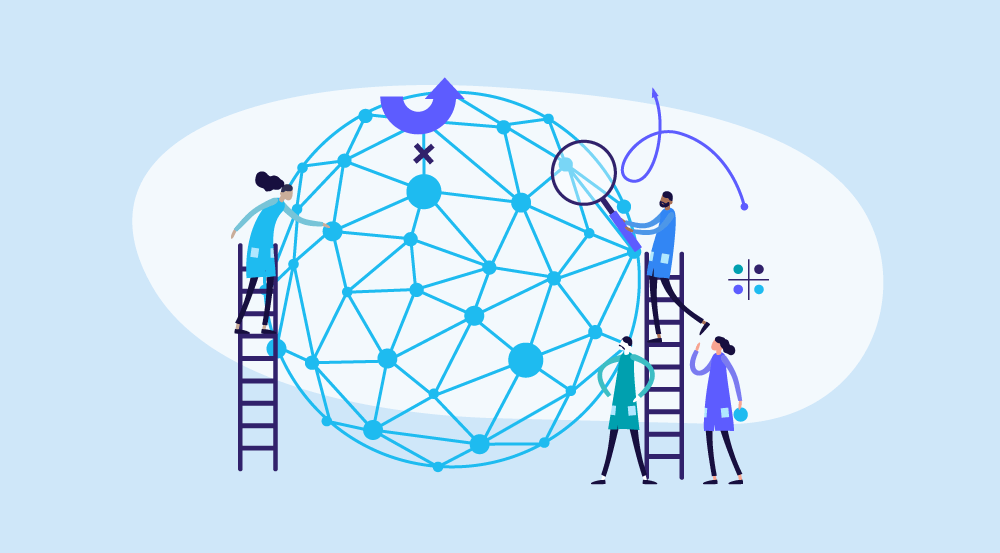Anticipated for the year 2023, the value of the worldwide artificial intelligence (AI) market is estimated to reach approximately $164.99 billion.
Forecasts indicate a remarkable growth trajectory, with expectations for the market to expand significantly to about $1,591.03 billion by the year 2030.
This growth is set to occur at a Compound Annual Growth Rate (CAGR) of 38.1% throughout the forecast span spanning from 2022 to 2030.
That's a significant increase!
The important question is: how does it all pan out for the Saudi government, and the KSA region?
In this post, we’ll look into different aspects of AI in workforce management in different industries; how different corporations are using AI in the workplace, and the overall effects of artificial intelligence – as in whether AI in workforce management is something detrimental to workflow, or it's on the contrary.
Read on…
The Prospects of AI In Workforce Management In Saudi Arabia
AI in workforce management is a key topic under the 2030 Vision of the Kingdom of Saudi Arabia (KSA).
In 2016, a strategic framework was developed to integrate AI into the new mega-city Neom.
The Vision 2030 reform plan aims to free the kingdom from dependence on oil exports by implementing economic and social policies.
As part of this plan, the KSA made history in October 2017 by granting citizenship to a humanoid named Sophia, produced by Hanson Robotics.
Sophia spoke at the Future Investment Initiative, an annual investment forum.
In line with its AI ambitions, the KSA planned to host a global summit for AI in 2020.
The summit aimed to bring together decision-makers, experts, and specialists from both the public and private sectors, including technology companies, investors, and businessmen.
It aimed to position Saudi Arabia as the world leader in AI events.
The Global Artificial Intelligence Summit
To fulfill this plan, the Global Artificial Intelligence (AI) Summit was organized by the Saudi Data and AI Authority (SDAIA) in September.
Held virtually from October 21-22, the summit was titled "AI for the Good of Humanity" and was held under the patronage of Crown Prince Mohammed bin Salman.
The decision to hold the summit virtually was a precautionary measure implemented by the Saudi government due to the ongoing pandemic.
These advancements are aimed at delivering key business priorities such as citizen experience, digital operations, sustainability, and security.
As Saudi Arabia strives to become a true digital economy, artificial intelligence capabilities will be integrated into every digital transformation initiative.
Majid Ali Al-Shehry, general manager of the SDAIA's Studies Department, emphasizes the importance of AI for Saudi Arabia's future.
He believes that data is the oil of the future and the SDAIA is working to unlock the potential value of data through various aspects of operation, regulation, and innovation.
The Middle East is starting to understand the importance of AI and advanced technologies in the global shift.
Governments and businesses in the region are faced with a decision: embrace the technological disruption or risk falling behind.
Falling behind is not an option when considering the economic impact.
By 2030, the Middle East is projected to receive 2% of the global benefits of AI, which amounts to around US$320 billion.
Saudi Arabia is expected to experience the largest economic gains from AI.
It is estimated that AI will contribute over US$135.2 billion to their economy in 2030, equivalent to 12.4% of their GDP.
On the other hand, the UAE is projected to have the highest impact relative to their GDP, with a potential increase of almost 14% by 2030.
These numbers highlight the potential for growth and development through the integration of AI technologies in the Middle East.
It is clear that embracing these advancements is crucial for staying competitive in the global landscape.
By harnessing the power of AI, governments, and businesses in the region can position themselves as leaders in the fourth industrial revolution.
Saudi Region Harnessing Ai To Win Big
The first wave of digitization has already made an impact, but with AI, new market leaders could emerge in just a few years.
Companies need to start exploring AI possibilities and setting strategies now to stay ahead.
The region has the opportunity to inject $320 billion into its economy through AI, but there's so much more to gain if governments and businesses fully embrace and develop AI.
Endless opportunities await those who seize the potential of AI. It's an exciting time for the Middle East, as AI can revolutionize industries and bring about significant economic growth.
So, businesses and governments must invest in AI and nurture its development.
Some parts of the region have already embraced AI and the new digital age.
The International Data Corporation (IDC) estimates that spending on cognitive and artificial intelligence (AI) systems in the Middle East and Africa (MEA) region will grow from $37.5 million in 2017 to over $100 million by 2021, representing a growth rate of 32% per year.
This shows that AI is gaining traction in the region.
Looking beyond 2030, the impact of AI on the economy and society is expected to increase. It is therefore important for the Middle East to strategically position itself for the future.
The UAE, Saudi Arabia, and Qatar have already shown a strong commitment to developing and implementing AI technologies.
They have invested heavily in new technology, with the support of their respective governments.
However, in other parts of the region, the adoption of AI has been slower.
This is due to factors like infrastructure and access to skilled labor, which are crucial for AI development. These differences in adoption levels highlight the challenges that need to be addressed.
It is worth noting that the volatility in oil prices is affecting the economic prospects of the region. Governments are now seeking alternative sources of revenue and growth.
Investing in AI technologies and developing non-oil sectors could be a strategic move for the region in the years to come.
This would help diversify the economy and reduce dependency on oil.
The gains from AI at the industry level depend on two main factors.
Firstly, if a sector has processes that can be automated, like retail and health, they will likely see the biggest gains from AI.
These sectors will benefit from increased productivity through AI adoption.
Secondly, sectors that have strong use cases for AI applications will innovate early on.
For example, PwC's Data Analytics team developed an AI Impact Index to assess potential product enhancements by 2030.
They looked at almost 300 use cases and identified health, automotive, and financial services as having the highest potential for product enhancements.
Investing in AI technologies can strategically develop non-oil sectors for the future. This will position the region well in the coming years.
However, the gains from AI will not be limited to specific sectors. As sectors that use AI grow, their demand for inputs from other sectors will also increase.
Additionally, higher wages in AI-driven sectors will boost consumer demand across the economy.
These indirect and induced impacts of AI will be felt by firms and consumers throughout the economy.
They will contribute to the overall economic impact of AI.
13 Opportunities that AI In Workforce Management Brought Over After Its Inception
Here are some of the key ways AI has impacted and continues to shape AI workforce planning.
1. Efficient Talent Acquisition
AI-powered tools assist HR departments in identifying the most suitable candidates for job openings.
By analyzing resumes, social profiles, and interview responses, AI helps streamline the recruitment process, reducing time and effort while improving the quality of hires.
2. Data-Driven Decision-Making
AI enables data-driven decision-making by analyzing large volumes of workforce data.
This assists in predicting trends, identifying patterns, and making more informed choices related to employee engagement, performance, and retention.
3. Predictive Analytics for Retention
With AI, organizations can predict which employees are at risk of leaving based on factors like job satisfaction, performance, and historical data.
This proactive approach allows companies to take measures to retain valuable talent.
4. Personalized Employee Experiences
AI can create personalized experiences for employees.
Chatbots, for instance, can answer routine queries, provide onboarding assistance, and offer learning recommendations, enhancing employee engagement and satisfaction.
5. Skill Development and Learning
AI-driven learning platforms can assess employees' skills and suggest personalized learning paths.
This helps in upskilling and reskilling, ensuring that employees stay relevant in a rapidly evolving job landscape.
6. Performance Management and Feedback
AI-powered performance management tools can provide continuous feedback and performance insights.
This real-time feedback loop helps employees improve and ensures that managers have data-driven discussions during performance reviews.
7. Workforce Planning and Scheduling
Artificial intelligence optimizes AI workforce planning by considering factors like employee preferences, skill sets, and historical data.
This leads to better utilization of resources and improved employee work-life balance.
8. Health and Wellbeing Monitoring
Wearable devices and AI-driven applications can monitor employee health and well-being.
This data can be used to tailor wellness programs, reduce absenteeism, and enhance overall workforce wellness.
9. Diversity and Inclusion
AI can assist in mitigating bias during the recruitment process and analyzing pay discrepancies, promoting fair practices, and improving diversity and inclusion within the workforce.
10. Remote Work Management
The rise of remote work has been facilitated by AI-driven tools for communication, collaboration, and project management.
These tools help manage remote teams effectively.
11. HR Automation
Routine HR tasks, such as payroll processing, leave management and benefits administration, can be automated using AI, freeing up HR professionals to focus on strategic initiatives.
12. Workforce Analytics
AI enables deep insights into workforce dynamics, helping organizations understand what drives productivity, engagement, and turnover.
These insights inform strategic decisions.
13. Succession Planning
AI can identify potential leaders within an organization based on performance data and skill assessments, aiding in effective succession planning.
15 Potential Challenges of AI In Workforce Management
While AI offers numerous benefits to workforce management, it also presents certain challenges that organizations need to address.
Here are some potential challenges associated with the integration of AI in workforce management:
1. Data Privacy and Security
AI in workforce management faces challenges when it comes to data privacy and security.
AI relies heavily on data, and handling sensitive employee data raises concerns about privacy and security.
Organizations must ensure that AI systems comply with data protection regulations and safeguard sensitive information.
2. Bias and Fairness
AI algorithms can inadvertently amplify biases present in historical data, leading to biased decision-making in areas like recruitment, performance evaluation, and promotions.
Ensuring fairness and reducing bias in AI models is a critical challenge.
3. Lack of Human Interaction
Another challenge of AI in workforce management is the lack of human interaction.
While AI can automate many tasks, there is a risk of losing the personal touch and human interaction that is crucial for effective communication, collaboration, and empathy within a workforce.
4. Skill Gaps and Resistance
Implementing AI systems may require employees to acquire new skills or change their work habits.
Resistance to change and skill gaps could arise, leading to reluctance in adopting new AI-driven processes.
5. Over-Reliance on AI
Relying too heavily on AI without human oversight can lead to errors going unnoticed and decisions being made without critical human judgment.
This can be particularly problematic in complex or sensitive situations.
6. Loss of Jobs
The fear of job displacement due to automation is a significant concern.
While AI can augment tasks and roles, some jobs may become redundant, requiring organizations to address workforce transitions and reskilling.
7. Misinterpretation of AI Outputs
Misunderstanding or misinterpretation of AI-generated insights or recommendations could lead to faulty decision-making and unintended consequences.
8. Algorithmic Transparency
Complex AI algorithms can be difficult to interpret, making it challenging to explain decisions or actions taken by AI systems.
This lack of transparency can erode trust among employees.
9. Implementation Costs
Integrating AI systems into workforce management processes can involve significant upfront costs, including technology investment, training, and ongoing maintenance.
10. Unpredictable AI Outcomes
AI systems can exhibit unexpected behavior due to their reliance on data patterns.
This unpredictability can pose risks in critical decision-making processes.
11. Data Quality and Availability
AI relies on high-quality data. If the data used for training AI models is incomplete, inaccurate, or biased, it can lead to inaccurate predictions and suboptimal outcomes.
12. Dependency on Technology
Overreliance on AI tools can create vulnerabilities in case of technology failures or outages, disrupting essential HR processes.
13. The complexity of Integration
Integrating AI systems into existing workforce management processes requires careful planning and coordination.
Poorly integrated systems can lead to confusion and inefficiencies.
14. Continuous Learning and Adaptation
AI models require continuous learning and adaptation to remain effective.
Organizations must allocate resources to ensure AI systems remain up-to-date and relevant.
15. Ethical Considerations
Ethical dilemmas can arise when using AI in the workplace in areas like employee monitoring, performance evaluation, and decision-making.
Organizations need to establish ethical guidelines and standards.
organization's growth, employee satisfaction, and overall success.
Enabling Organizations through Customized Learning Paths and Advanced Insights
Oreed: Pioneering Employee Training for Tomorrow
Oreed, an innovative education intelligence platform, is propelling employee training into an era of personalized learning journeys tailored to each individual.
Through the application of advanced analytics, organizations are empowered to comprehend their workforce's strengths, areas for improvement, and precise training requirements.
Gaining a Holistic Perspective on Employee Capabilities and Training Needs
Incorporating Oreed yields a comprehensive view of your personnel, facilitating a nuanced understanding of individual talents and opportunities for growth.
This invaluable perspective becomes the foundation for focused training strategies designed for maximum efficacy.
Data-Driven Enhancements for Skills and Performance
The analytical prowess of Oreed translates data into actionable insights, facilitating evidence-based decision-making.
By identifying avenues for skill enhancement and performance optimization, Oreed contributes to the overarching advancement of the organization.
Tailored Learning and Courses
Bid farewell to generic training regimes as Oreed redefines learning content to align with the distinct requirements of each team member.
Strengthening existing proficiencies and addressing areas in need of development, this tailored approach cultivates engagement and amplifies knowledge retention.
Assessing the Impact and Efficacy of Training Initiatives
Oreed's meticulous analytics and reporting capabilities provide a comprehensive appraisal of the effectiveness of your training endeavors.
Monitoring progress, delineating success metrics, and perpetually refining training programs solidify optimal returns on investment.
Centralized Learning Hub for Seamless Experiences
Oreed simplifies the learning journey by consolidating all learning resources and materials within a single, intuitive platform.
By streamlining access to knowledge, Oreed enhances the efficiency and gratification of the learning process.
Elevating Productivity, Efficiency, and Profitability
Harnessing Oreed's guided learning journeys and robust training tools propel employee productivity and efficiency to new heights.
This transformative impact resonates throughout the organization, bolstering profitability and sharpening the competitive edge.
Harmonizing with KSA's 2030 Vision through Mastery and Discipline
Oreed's approach to employee development harmonizes seamlessly with KSA's 2030 vision, emphasizing mastery and discipline.
By encouraging employees to refine their expertise, organizations contribute to the realization of long-term objectives.
So why wait? Give Oreed a try today and see the difference it can make for your organization.
Promote lifelong learning through Oreed by experiencing the most powerful all-in-one training and development intelligent platform that streamlines all your organization's learning, training, and development activities in one place.





